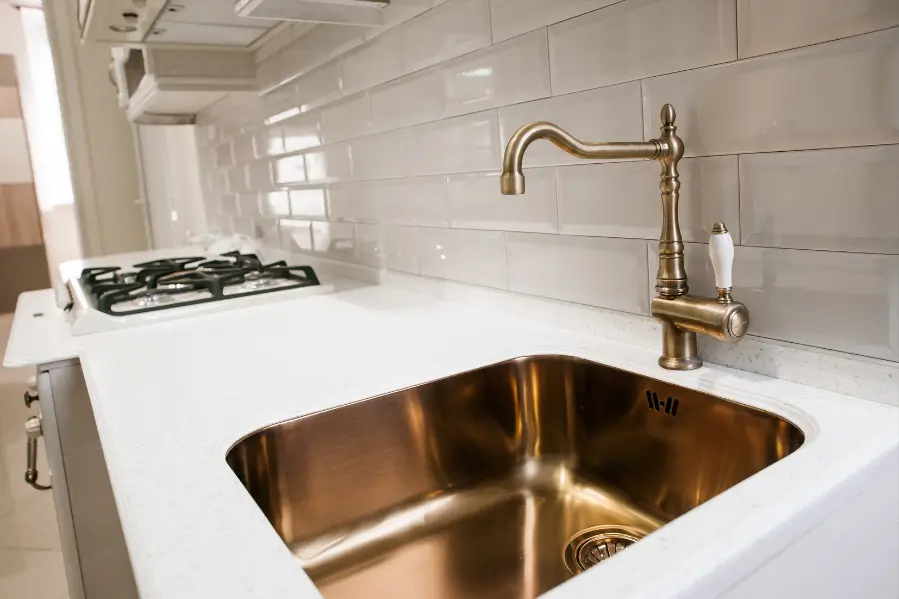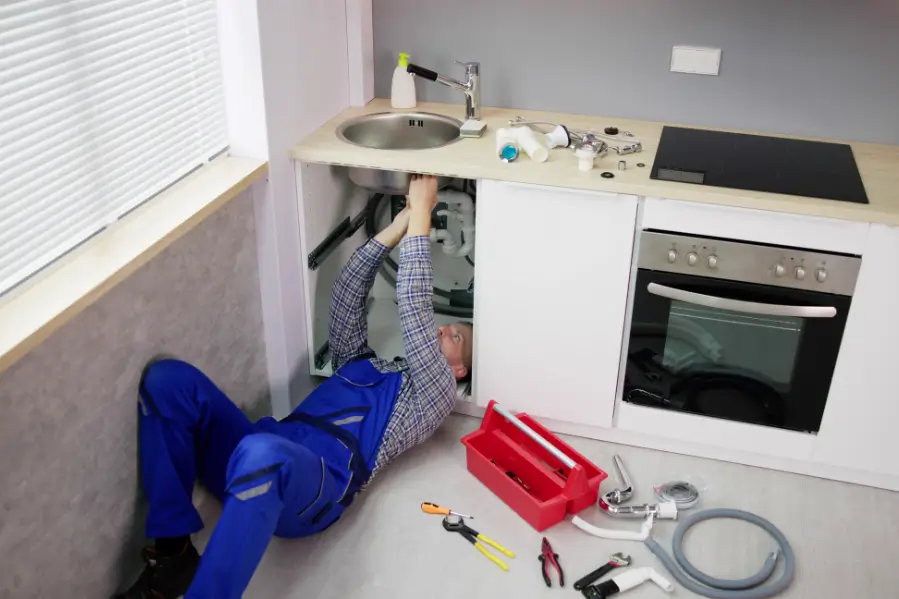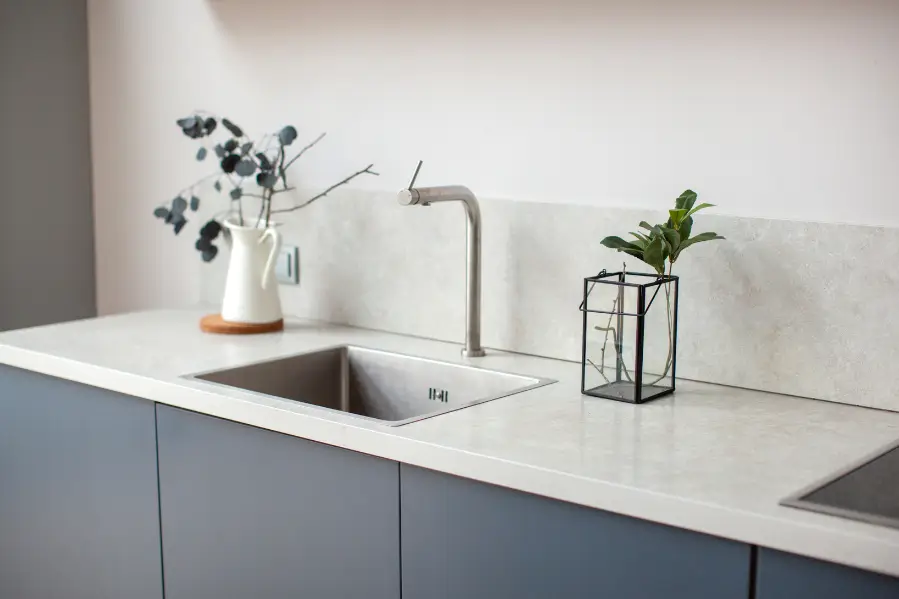Installing a kitchen sink yourself is entirely doable with a bit of organization and the right guidance. This comprehensive manual will walk you through each step, helping you enhance your kitchen’s functionality and style.
Replacing your sink can be a great way to refresh your kitchen, whether you’re simply updating its look or improving its practicality. With the correct tools and materials, even skilled professionals can replace a sink and faucet in just a few hours.
Follow these straightforward steps, and you’ll be on your way to a seamless professional looking installation that transforms your kitchen space.
What You’ll Need
Equipment / Tools
- Bucket
- Channel locks
- Utility knife
- Bar clamp
- Screwdriver
- Wrench
- Jigsaw
- Caulking gun
Materials
- 2×4 board
- Sink clips
- Silicone caulk
- Plumbers putty
Step-by-step Guide to Install Kitchen Sink

When it comes to kitchen remodeling, installing a new sink can be a significant upgrade, adding both functionality and aesthetic appeal to your space. The following guidelines are designed to help you get started from scratch.
If your project only involves replacing an existing sink, you can skip step four and simply remove the old sink before moving on with the installation process.
1. Measure and mark the sink layout
To center the sink within its cabinet, start by tracing the rear edge of the counter. If your sink comes with a template, position it so its back edge is 1.5 inches from and parallel to the counter at this location. Outline by tracing around it. If your sink lacks a template, you can mark the placement of the sink using two-inch tape.
On the back lip of the sink, mark the middle. Ensure the backsplash and the sink’s back border are separated by 1.5 inches. Verify that the sink is in line with the edge of the counter. After tracing all around the sink, take it out.
2. Mark the cut line
Measure the width of the sink lip and deduct 1/8 inch to draw the cut lines. Next, mark the interior of the sink outline using this measurement. Your cut lines are created by joining these markings with a straightedge. To match the radius of the sink’s corners, manually round off the corners.
3. Cut the Sink Opening with a Jigsaw
Make sure to drill a hole inside the radius at every corner of the cut-out lines using a spade bit that is slightly broader than the jigsaw blade. Place a piece of wood scrap across the sink area that is a few inches longer than the cutout. To keep the junk from falling or binding the saw blade, screw through it and into the cutout waste.
After carefully cutting along the lines you have marked, insert the jigsaw blade into one of the drilled holes. After finishing the cuts on both sides, take out the cutout portion. Check the sink’s fit and adjust the opening if needed.
4. Install the Faucet and Sink Components
To safeguard the sink, place it upside down on a softened surface. Pass the supply tubing and tailpiece of the faucet through the gasket and up through the sink’s hole. Screw on the mounting nuts and washers from underneath to secure the faucet. Before tightening the mounting bolts all the way, make sure the faucet can swing across the sink in a complete arc.
5. Secure the Strainer and Drain
Apply a generous layer of plumber’s putty beneath the strainer’s lip. Pull the strainer upward through the drain hole in the sink. Put on the gasket, washer, and housing from below.
Put pipe-joint compound on the threads that are showing. Holding the strainer in place, thread the lock nut onto it by hand and tighten it using pliers. Using the gasket and slide nut, fasten the sink-drain tailpiece to the strainer.
6. Set the Sink and Connect the Water Supply
The countertop area surrounding the cut-out has to be well-cleaned. Apply a continuous bead of silicone caulk along the underside of the sink’s lip while it is still upside down. To achieve a watertight seal, make sure the bead is uniform and gap-free. Once the sink is properly aligned, gently drop it into the cutout. To set the sink into the sealant, firmly press down.
Verify that the front of the sink and the front border of the countertop are parallel. Install mounting clips immediately, following the manufacturer’s directions, if your sink model calls for them. Using a moist cloth, remove any extra caulk that squeezes out. Before making any plumbing connections, let the sealant cure according to the manufacturer’s recommendations.
Connect flexible supply lines to the faucet tailpieces once it has been set. Use braided stainless steel hoses or acorn-head supply tubes to connect the faucet to shut-off valves. Using an adjustable wrench, tighten all connections; however, take care not to overtighten. Connect the sprayer’s hose to the threaded tailpiece of your faucet if it has one.
7. Install the drain pipes

Connecting the drain of the sink to the parts that go between the sink’s tailpiece and the waistline is the most difficult aspect of installing a new sink and faucet. Always work your way down from the sink tailpiece.
Attach the sink-drain tailpiece to the trap adapter. To connect the drain elbow to the waste line and the trap adapter to the P-trap, cut and dry-fit lengths of PVC pipe. To fine-tune the lengths and alignment of the pipes, either slide the trap or adjust it on the tailpiece.
As soon as everything fits well, take the parts apart. After using a utility knife to clean the cut ends, prime all connecting components with PVC primer. Once the two ends of the joint have been coated with PVC cement, press the parts together and hold them in place for 30 seconds. Put all threaded connections back together, tightening them by hand.
8. Connect the Dishwasher Drain
Locate the dishwasher drain connection on the garbage disposal or sink’s tailpiece if you wish to connect your dishwasher. Connect the drain hose for your dishwasher to this port. Using a screwdriver, tighten the hose clamp to secure it. To stop backflow, make sure the hose is attached to the underside of the countertop or has a high loop.
9. Test for Leaks
Remove the air diffuser from the faucet to prevent it from clogging with debris. Turn on the water supply valves slowly. Run the water at full blast and observe all connections along the supply and drain lines. If you notice any leaks, tighten the connections carefully, making one-eighth turns until the leak stops.
Fill the sink with water to check for leaks around the drain and to ensure proper drainage. Run the garbage disposal to check for leaks and proper operation.
Make sure the sink’s front edge is parallel to the counter’s edge. Fill the sink with water to weigh it down and hold it tight overnight as the caulk sets.
How to Take Care of Your Newly Installed Kitchen Sink
To keep your sink in top shape and to increase its longevity, follow these easy maintenance steps:
- Steer clear of harsh chemicals that might harm the sink’s finish.
- Regularly wash with water and mild soap.
- To keep the water flowing smoothly, clean the aerator every few months.
- Check for leaks under the sink regularly.
- To prevent scratches on the bottom, use a sink grid.
Transform Your Kitchen with Smart Remodeling LLC’s Expert Touch in Houston
At Smart Remodeling LLC, based in Houston, Texas, we offer a comprehensive suite of kitchen remodeling services designed to elevate both residential and commercial spaces. Specializing in customized designs, we provide high-quality kitchen cabinets, expert cabinet painting, and a wide selection of countertops, flooring, and backsplash options to suit any style.
Our innovative approach incorporates the latest trends, ensuring your kitchen not only looks stunning but also functions efficiently. From start to finish, our experienced team is dedicated to crafting kitchens that enhance both the aesthetic appeal and value of your property.
Conclusion
Installing a new kitchen sink can be a rewarding project that adds both functionality and style to your space. While many skilled DIYers can tackle the job independently, others may prefer the expertise of a professional, especially for complex installations or plumbing modifications.
Whether you decide to take it on yourself or work with a plumber, updating your sink is a valuable investment that enhances your kitchen’s utility and can even increase your home’s overall value.






